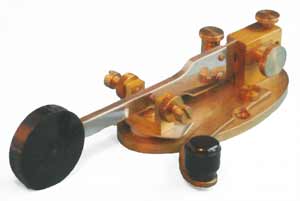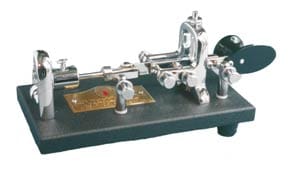Vibroplex, Mechanical Bug Morse Key History
The Vibroplex is now established as a classic semi-automatic mechanical bug Morse key, but it was not the first or only type of bug.
Morse Telegraph History Includes:
Morse telegraph history
Morse keys development
Vibroplex & mechanical bug keys
Telegraph sounder
Morse inker
Samuel Morse
Fascinating facts
Morse code SOS message
Morse keys:
Clipsal key
Camelback
Walters Electrical Patt 1056A Post Office key
Steel lever Morse telegraph key
RAF Bathtub Morse key
Samson ETM-5C electronic keyer
The impetus for automatic keyers and the Vibroplex key was provided by the fact that many telegraph operators suffered from a condition known as "Telegraphers Cramp" or paralysis. This was a form of what is known today as repetitive strain injury or RSI.
The Vibroplex was not the first solution to this problem, indeed it was not even the first mechanical bug key.
First steps - the sideswiper
One of the first solutions on the road to the Vibroplex key was the sideswiper Morse key. Rather than moving a key up and down for each dot and dash, this key used sideways movements and had contacts on either side. In this way the number of movements was considerably reduced - this basic approach was adopted later for the Vibroplex in that a sideways movement was used.

Contact can be made by moving the lever to either side
While these keys did something assist those who suffered this cramp or paralysis, it was not the whole solution, but only the next step on the way to the invention of the Vibroplex key.
Another idea that provided further assistance, was the introduction of a new form of abbreviations code called the Phillips Code, named after Walter Phillips who introduced it in 1879. This consolidated many of the standard abbreviations created by operators. Whilst this helped the situation, it was not a complete answer.
Vibrating arm - the beginnings of the Vibroplex bug key
The key concept behind the Vibroplex key is the vibrating mechanical arm that enabled multiple dots to be created. This concept needed to be applied to Morse keys before the Vibroplex could be made.
The main issue for many telegraph operators was that of the wrist and hand movements required to make the dots. A number of people came up with the idea of using a vibrating arm to generate the dots automatically.
The early attempts were not particularly successful because of the lack of damping that meant that sending was erratic and dots were often split.
Although not a success, the first attempts at making what is now termed a bug key were crucial for later developments.
Typewriter 'keys'
Another solution that was investigated was that of using a form of typewriter that generated Morse characters when the keys were depressed. Developed in 1902 by Charles Yetman, this was in many respects, an early form of teleprinter, although the receiving of the Morse was undertaken using a sounder in the normal way.
Despite its revolutionary nature, this concept did not take off, possibly because way in which the telegraph industry was organised.
More bug key developments
Another inventor named Horace Martin (the actual inventor of the Vibroplex key) was addressing the issue of damping the arm that made the dots. In 1903 Martin was granted Patent 732 648 for a telegraphic transmitter. This was the first real mechanical bug key and was called the 'Autoplex.'
The Autoplex was battery powered and used electro-magnets to keep the vibrator stationary when it was not required.
The patent Martin received included a great variety of ways of making dots. This was a shrewd move as it meant that virtually all the competition could not circumvent the intellectual property that Martin set out in the patent.
Vibroplex bug key born
Whilst the Autoplex keyer was gave a significant improvement over any other automatic keys that were available, it was still large and bulky and required power. Many telegraph operators took their keys with them and they needed something that was more compact and reliable.
Martin continued to work on ideas for semi-automatic bug keys and his development started to pay dividends.
In 1904, a year after the launch of the Autoplex, he introduced a new key that he called a Vibroplex.

Martin filed the patent for his idea on 7 May 1904. However another inventor named William Coffe filed a patent on 11 January 1904. Although Coffe's patent was filed earlier, it was very general in its wording encompassing many aspects of keyers. As a result it was granted after that of Martin's but it left the field open for litigation later.
The very first Vibroplex keys used a straight strip of metal attached to the pendulum, but in 1906 he developed the mechanism further to provide the "U" arrangement used to this day (see diagram).
The Vibroplex used the vibrating arm principle but had mechanisms to damp the vibrations when they were no longer required. It was also possible to adjust many of the essential operating settings so that everything from the movement of the paddle to the mark space ratio on the dots could be set.
Another development was to use a double lever key that had a separate lever for dots and dashes. This helped overcome the issue they had with split dots.
Vibroplex manufacturing
The first Vibroplex keys were custom manufactured by Martin at his shop in Brooklyn New York. He continued this way until about 1912 when the name Vibroplex was registered and around this time he also linked with the Albright Company to manufacture the keys.
The Vibroplex keys became very popular and were used by many telegraph operators and they were also adopted by many large organisations.
They were widely used by the US military in World War 1. They were in fact, so busy that it prevented development of the keys as production quotas needed to be met.
Vibroplex 'Lightning Bug'
After the First World War, it took a few years before the next major introduction occurred. In 1923, the Lightning Bug incorporated several improvements and enabled smooth and efficient Morse transmission.
It was this key that was adopted by the US military Signal Corps during World War 2 and known as the J-36. Also the US Navy selected it as their speed key.
Bugs on the air
The very nature of the Vibroplex mechanical bug key meant that it was not suitable for high current applications. With initial wireless transmissions being spark transmitters, which required high voltages and current levels to be switched, the bug was not suitable for these applications. However as valve or vacuum tube based transmitters using a carrier that was interrupted, CW transmissions started to be used, so too the bug key could be used for radio or wireless transmissions.

Although care had to be taken to prevent the contact bounce from the dots causing key clicks - a simple filter could be used - these keys were ideal for high speed radio transmissions. This transition started in the late 1920s and early 1930s.
Martin leaves
Horace Martin, the founder of Vibroplex and the inventor of the mechanical semi-automatic bug key, decided to leave his company in the 1930s. He set up another company called the Martin Research and Manufacturing company which made 'Martin Flash Keys.'
In 1940, Martin sold this company along with all the manufacturing jigs to J H Bunnel, manufacturer of straight keys. Bunnell then produced these keys under the name 'Bunnell Martin Flash keys.'
Vibroplex keys today
Although originally founded in New York, now over 110 years later, the company is located in Knoxville, Tennessee, USA. It continues to manufacture the original Martin bug key but it also increased the line to make a variety of keys for the current marketplace including mechanical bugs, iambic paddles, single-lever paddles and traditional straight keys.
 Written by Ian Poole .
Written by Ian Poole .
Experienced electronics engineer and author.
More History:
Radio history timeline
History of the radio
Ham radio history
Coherer
Crystal radio
Magnetic detector
Spark transmitter
Morse telegraph
Valve / tube history
PN junction diode invention
Transistor
Integrated circuit
Quartz crystals
Classic radios
Mobile telecoms history
Vintage mobile phones
Return to History menu . . .


